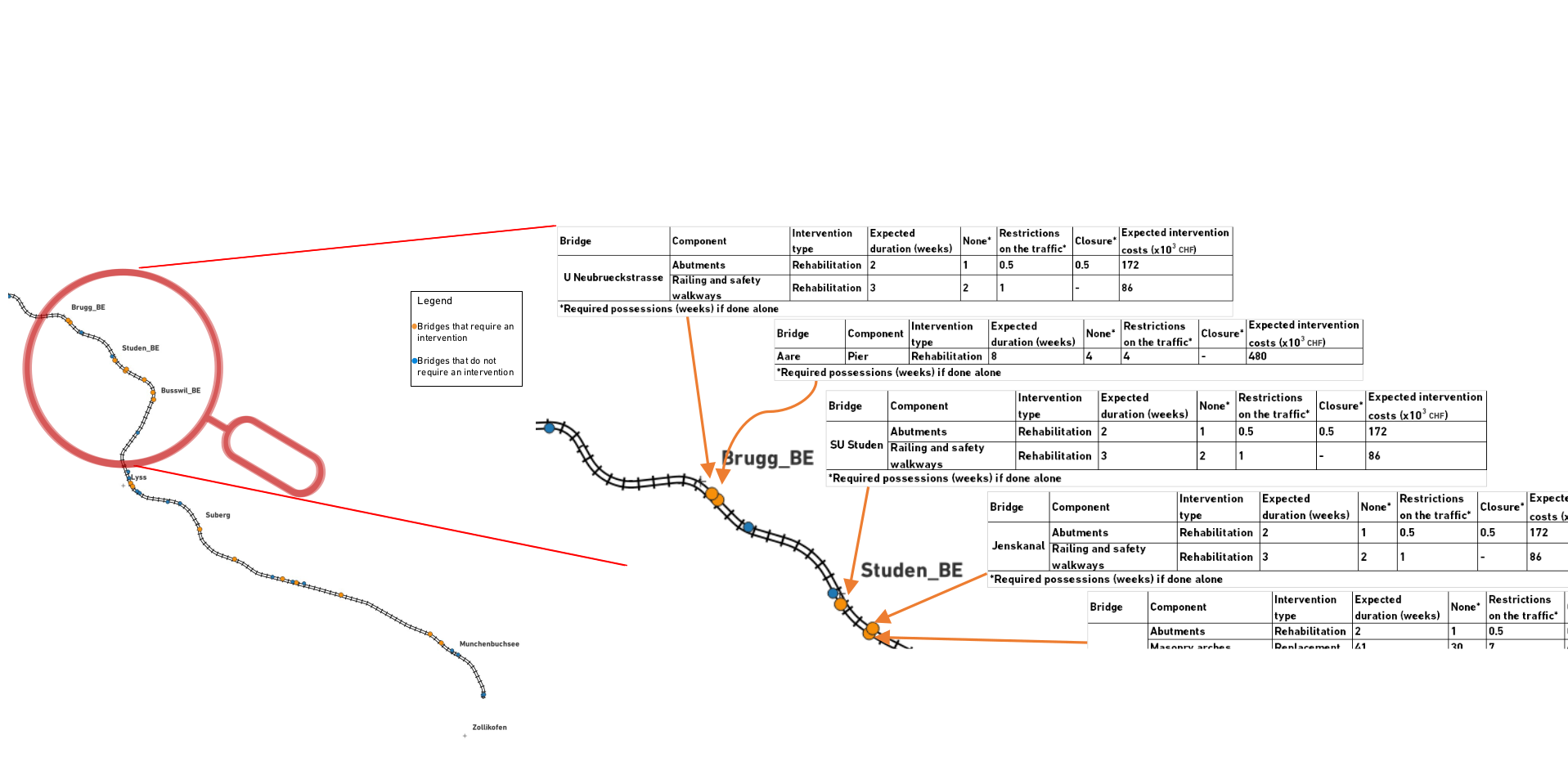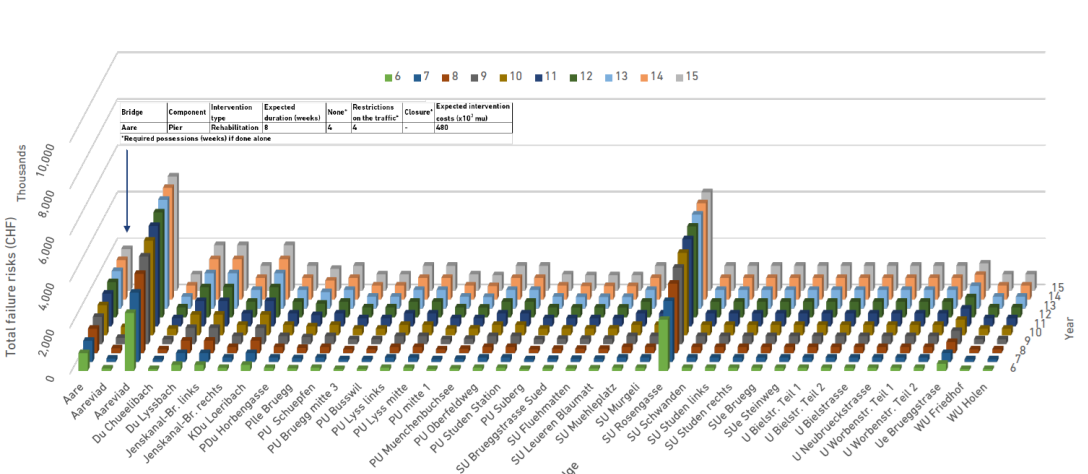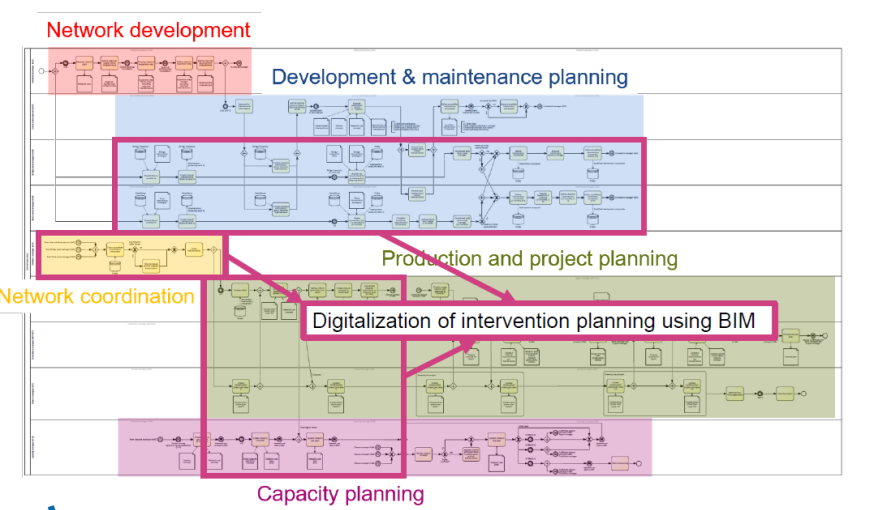Maintaining train schedule STABILITY and managing time table reserves via digitalised railway intervention planning
A recently concluded research project funded by the Mobility Initiative and conducted by the Chair of Infrastructure Management led by Professor Bryan Adey together with SBB experts proposed methodologies to help asset managers plan future interventions more effectively and efficiently using digital tools.

Motivation
The future of rail transport will be one where trains carrying passengers and goods flow seamlessly from their origins to their destinations. Potential disruptions due to train incidents will be foreseen with the extensive use of surveillance technologies, and either prevented through the implementation of detailed action plans or their consequences eliminated with the seamless rerouting of trains. Interventions on the infrastructure, whether it be the grinding of tracks or the expansion of train stations, will be carried out in perfectly allotted slots in train schedules. Train schedules will be stable, and the use of train schedule reserves will be maximised.
The project STABILITY contributes to fill the knowledge gaps remaining to realize this vision by developing a new integrated railway intervention planning process that enables the optimal exploitation of digital tools.
Decision support tools to improve train schedule - intervention planning
For the development of train schedules, it is necessary to know far in advance when and which interventions are required on different components of infrastructure, as well as the extent of required possession windows, the failure risks when postponing interventions, and costs.
There is a large and growing amount of detailed information on current conditions, their likely evolution over time, the risk of failure and the possible preventive interventions as well as cost and impacts on the service of executing them. SBB now has the chance to improve its intervention planning process to make even more consistent and complete estimates of the future required interventions and associated track possessions.
Within the first part of the project, the team modeled the intervention planning process at the SBB after conducting several interviews with stakeholders who make decisions in the process. They described their responsibilities, required inputs to make decisions, and where the outputs of their decisions flow. They also detailed the tools, data and databases they use, and it is evident that the communication and sequence of decision-making is complex and interdependent across teams and time. The result of understanding the intervention planning process allowed the STABILITY team to identify the areas in which the use of digital tools could improve the overall efficiency and effectiveness of planning process, specifically by bridge asset managers, track asset managers, network coordinators, and production and project managers.
With an understanding of the intervention planning process, it was then necessary to facilitate decision-making with appropriate input data for planning future interventions. To deal with imperfect data, a methodology to impute the missing asset condition data was developed. The methodology uses Bayesian networks to structure the influencing factors affecting deterioration, the Analytic Hierarchy Process to solidify expert opinions, Monte Carlo methods to simulate the asset condition data from all the possible combinations of deterioration mechanisms, and non-homogeneous transition matrices to model the deterioration over time. This results in probabilistic estimates of the current and future condition states of the assets, which can be used as input data to estimate the required interventions.
The team then developed algorithms to make initial complete and consistent estimates of the type and time of future condition-based interventions on SBB railway bridges, tracks, and switches at the component level. The algorithms enabled the use of wide range of existing data ranging from expert opinion where there is no data available to the detailed condition reports available in the SBB databases. An indication of the failure risks is obtained for each railway asset, this information is used to prioritise component-level interventions.
Optimal sequencing of component-level maintenance interventions
To ensure that interventions on railway networks are executed to cause the least disruption to service, an efficient and effective method for sequencing interventions is needed, which also ensures the lowest interruptions to traffic.
An algorithm to maximise the net-benefit of interventions was developed to determine optimal component-level intervention programs for railway networks. The algorithm was tested on a 25 km railway network located in the canton of Berne between Brügg and Zollikofen. A comparison between two cases was made to demonstrate the effectiveness of the proposed algorithm: one that considers dependencies between the interventions to determine the optimal component-level intervention programs, and another that does not. The results indicate that the algorithm considering dependencies can substantially reduce the service disruptions needed to execute interventions.
Digitalised intervention planning process
The developed methodologies and predictive algorithms to estimate asset condition states, future component-level interventions, and optimised intervention programs, would help managers make more efficient and effective decisions. They need, however, to be in the right digital environment to facilitate the communication between stakeholders. Building Information Modeling (BIM) provides that platform.
To integrate the digital tools of predictive algorithms developed in STABILITY into BIM, a methodology was established to create a digital model of the 25 km railway network and its assets in Autodesk Revit, including bridges and tracks, as well as their components. The model uses Dynamo to connect the results of the predictive algorithms on asset condition states and planned interventions to defined properties of the 3D digital models, and subsequently uses Dynamo Player as the interface to visualise the results and enable decision-making. More importantly, distinction in the interface design is made between for asset managers, network coordinators, and production and project managers, to reflect the unique requirements needed to make decisions in each of part of the intervention planning process.
Final workshop
A final workshop was organised at SBB headquarters to demonstrate the research done in STABILITY to the stakeholders, where Prof. Dr. Bryan Adey presented the vision of the digitalised intervention planning and the role of STABILITY to help facilitate it, Steven Chuo presented the work on estimating asset condition states and digitalisation of the intervention planning process, and Hamed Mehranfar presented the work on estimating future interventions and optimisation of intervention programs. The event was well received by the infrastructure managers, engineers, and planners who attended, and led to productive discussions on integrating STABILITY methods into current planning processes. Some conclusion of the discussion are summarized below.
Conclusions
- Digital tools could enable making more effective and efficient decisions.
- Estimates of the current condition states are very useful for long-term planning, and the developed methodology is a reasonable approach in the absence of frequent inspections or real-time sensors.
- An overview of upcoming interventions and systematic risk assessment is necessary for optimized planning. The correlation between risk and the evolving condition estimations are an asset too.
- The effort to sequence interventions and generate intervention programs in advance is well justified.
Concluding thoughts
The researchers acknowledge the great support from the SBB team. As the STABILITY project was involved with many parts of the organisation, there was critical and not always straightforward. In particular, the support from the key steering committee members Thomas Wüthrich and Christoph Natz was excellent, as was the support and interaction with the bridge management team, i.e., Christoph Roggli and Vinitha Diggelmann. Closer interaction with the track managers and the production planning team would have been advantageous.
One of the main challenges of STABILITY was dealing with inconsistencies in the data, such as the asset coordinates, measured criteria, and the variance in the recording of data points. These inconsistencies required a significant effort to understand, clean, and preprocess, to make the data useful for the predictive algorithms. The SBB team were very open to share data and also valuable know-how, which were very helpful on this complex task.
With respect to the future, it is worth to point to the fact that there are potential difficulties in using digital tools to plan future interventions. These difficulties are related to the integration of methodologies into SBB legacy systems, ensuring the consistency and quality of the input data, and role-specific acceptance of the digital tools.
Enabling the use of digital tools in intervention planning, as it entails the involvement of different teams of people, requires a specific person or core team to be responsible for process improvement and they should be given the clear task to improve both efficiency and effectiveness. Nonetheless, as more digital solutions become available for decision-making, more data become also available from novel asset monitoring technologies, and continuing education evolves and focuses more on digitalisation in infrastructure management, it is anticipated that the research done in STABILITY will drive real impact to help enable effective and efficient intervention planning for the SBB.
Christoph Natz and Thomas Wüthrich, from SBB, followed up closely the project:
SBB Infrastructure operates a very busy and asset-intensive network, which is continuously maintained and expanded to ensure the highest punctuality.
The construction work for this should disrupt rail traffic as little as possible and always be implemented cost-effectively and safely. For this purpose and in view of the further growth in construction and traffic volumes, SBB has developed a strategy for future interval management, according to which construction work will be bundled even more than it is today.
“Construction work should disrupt rail traffic as little as possible and always be implemented cost-effectively and safely.”Christoph Natz and Thomas Wüthrich (SBB Infrastructure)
The ETH research project STABILITY is of great value in this respect, because it has developed a vision and solutions that can support the implementation of the strategy methodically and algorithmically. The collaboration with ETH was extremely interesting and very gratifying!
With regard to the transfer of findings from the research world to the application landscape, in addition to the challenges in the area of data completeness and data quality, it is crucial that the algorithms are implemented in tools that are easy for practitioners to use. This is one of the reasons why SBB has also followed ETH's recommendation to create a central unit that implements the process, efficiency and effectiveness improvements necessary for forecasting.
We would like to thank the ETH team, in particular Professor Bryan Adey and his doctoral students Steven Chuo and Hamed Mehranfar, for the pleasant and constructive collaboration. We look forward to future projects with ETH within the framework of the Mobility Initiative.
-

Professor Bryan Adey (Institute of Construction & Infrastructure Management, ETH Zurich) -

Steven Chuo (Institute of Construction & Infrastructure Management, ETH Zurich) -

Hamed Mehranfar (Institute of Construction & Infrastructure Management, ETH Zurich) -

Thomas Wüthrich (Portfolio Manager for Technical Feasibility Studies, SBB Infrastructure) -

Christoph Natz (Head of Central Interval, District, and Network Management, SBB Infrastructure)

